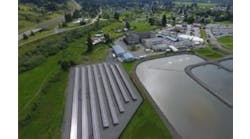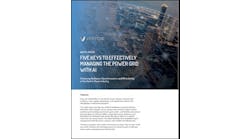The final article in our special report series on university microgrids describes microgrids as teaching tools. Read on for real-world examples of how microgrids help colleges and universities manage their energy assets, while also educating the energy engineers of tomorrow and serving local communities.
Get the full report.
The Bronzeville Microgrid: A Chicago neighborhood offers a glimpse of the future
Microgrids are impressive on their own, but what if they could work together? What if they could communicate and share resources via market participation— automatically with no human intervention —to achieve even greater efficiencies than they accomplish alone? In fact, what if the electric grid eventually became a grid of self-supporting, super smart and highly predictable microgrids?
It may sound futuristic, but the idea of clustering microgrids is already being explored on the southside of Chicago in a partnership that includes Siemens, a technical college and a local utility.
Known as the Bronzeville Microgrid, the project will pair a microgrid already in operation at the Illinois Institute of Technology (IIT) with a microgrid being developed by Commonwealth Edison (ComEd) for the Bronzeville community.
With $5 million in grant funding from the U.S. Department of Energy, the $25 million project is the first utility-operated microgrid cluster being developed in the nation.
Spurred by Bronzeville community members eager to make their backyard a showcase for clean technology, the project will demonstrate how microgrids support the integration of renewable energy into the grid, enhance grid security, and keep power flowing during emergencies. The Bronzeville community will use its microgrid to ensure reliable energy for 10 facilities that provide critical services, including the Chicago Public Safety Headquarters, the De La Salle Institute and the Math & Science Academy, a library, public works buildings, restaurants, health clinics, public transportation, educational facilities and churches.
“The Bronzeville community is well-known for innovation and entrepreneurship and commitment to building a bright future,” said Paula Robinson, president of the Bronzeville Community Development Partnership. “A secure energy infrastructure and greater access to renewable sources are central to our vision…. It’s time to put this technology to the test, and Bronzeville is the perfect place to do it.”
See the full report for details on the two phases of the Bronzeville Microgrid project.
Algonquin College demonstrates the economic ingenuity of the microgrid
Algonquin College, located in Ottawa, strives to be a model for exceptional energy management and sustainability and is ranked as one of the top 50 research colleges in Canada.
So it’s fitting that the college operates an advanced microgrid, which includes a 4-MW CHP plant, 500 kW of solar, 500 kW (3-hour) battery energy storage and electric vehicle charging stations—all controlled by a new level of software intelligence to create a cutting-edge “optimized” microgrid.
The college uses an advanced Siemens microgrid controller to network on-site generators to each other as well as the campus buildings and the outside electric grid. The controller continuously reconfigures use of microgrid resources based on their availability and energy market prices. It achieves this feat minute by minute. In doing so, the controller minimizes emissions, increases efficiency and reduces energy costs.
The expanded microgrid allows the college to operate entirely off grid when a power outage occurs or when being off grid off ers economic advantage.
Other times, the microgrid operates connected to the local utility grid, making valuable decisions based on real-time grid prices and the thermal requirements of the college. Automatically, and with no human intervention, the microgrid controller will decide the best mix of these resources at any given time.
Examples of some ways the microgrid can derive value include:
- Store energy in batteries and then use that energy to respond in a demand response event.
- Control load in response to market signals. For example, the campus heating requirements are seasonal and dynamic. If demand is low on the microgrid, the microgrid controller may choose to use on-site generators to heat the water. But, if the on-site generators are in demand, or if grid electricity prices are low, the college may instead tap into the grid for the necessary power.
- Forecast what is ahead for load and generation. The microgrid can look ahead to determine what mix of distributed generation resources will be most economical based on forecasted fuel prices.
The optimized microgrid creates a highly advanced learning lab for Algonquin students and researchers. Even more, the college is helping to open the door for communities, businesses and institutions worldwide that can benefit from this cutting-edge clean technology.
The Santa Fe Community College Microgrid: Preparing the Next Generation
Microgrids also provide community college students outstanding opportunities for training in technical jobs in the new energy economy. They have the potential to attract students back to the vital hands-on workforce. In an era of rapid-fire technological change, it’s not always easy for engineering students to train on the latest real-world tech. Campus microgrids, however, allow them to do just that, doubling as both teaching tools and clean energy generating assets serving the school.
A gold star example is emerging at Santa Fe Community College (SFCC) in New Mexico, which is building a microgrid training center in partnership with Siemens. Like Bronzeville, SFCC’s project demonstrates the value of linking disparate microgrids. In SFCC’s case, a nanogrid will power its greenhouse and link to a planned campuswide microgrid.
Its Building Energy Automation and Microgrid Training Center (BEAM TC) provides students with the critical training that links advanced building automation technology to microgrid energy control. This way, students learn how to manage the building’s heating, cooling and lighting, while simultaneously training in microgrid managed power generation and controls.
The microgrid will expand the reach of the building automation system so that it can integrate multiple energy systems, add resiliency to the grid in the event of power disruptions, optimize the energy systems and enable advanced cybersecurity.
Driving toward total energy independence, Algonquin College currently creates and directs part of its energy requirements. Photo credit: Siemens
The greenhouse nanogrid consists of a 100 kW (85 kWh) lithium ion battery and a 25 kW dual axis solar PV array, which will share power with a campus microgrid that will contain 1.5 MW of solar PV (existing), a 500 kW (500 kWh) lithium ion battery, and advanced Siemens microgrid controls. The 1.5 MW of existing solar PV, because of the addition of microgrid controls and advanced switchgear, will be able to remain connected to the campus during power outages. Like nearly all solar PV arrays connected to buildings, the array must be automatically disconnected during outages unless connected to a microgrid controller.
The new BEAM TC will be the first of its kind to train students in building automation and microgrids and how the two complement each other to allow interaction with the utility grid. SFCC’s new greenhouse (for advanced hydroponics and aquaponics) was designed to be powered by a fully integrated nanogrid, optimized for microgrid training opportunities. The nanogrid will become a node for the proposed campuswide microgrid.
The college is leveraging a $351,000 grant from the U.S. Economic Development Administration (EDA), $326,000 in state appropriations, and $111,661 in donated equipment and engineering expertise from Siemens and other industry partners. Santa Fe Community College president Rebecca Rowley said: “SFCC is proud to partner with Siemens Industries as well as U.S. EDA to be on the forefront of education and research in microgrid technology. The college has been a leader in workforce development in the sustainability arena by developing educational programs and training in solar (thermal and PV) electricity, controlled environment agriculture (both hydroponics and aquaponics), algae production and biofuels. Developing an educational and training program in microgrid technology was the next logical step to prepare our students to become a part of the new energy economy.”
U.S. Congressman Ben Ray Luján foresees the training center as making SFCC a statewide leader in building a green energy workforce and economy. “This grant recognizes their smart, forward-looking approach to ensure that students graduate with the skills to get good jobs in the renewable energy sector,” Luján said.
The project is expected to attract jobs and businesses to the region and position engineering students for employment in the rapidly growing microgrid industry. BEAM TC will be housed in the college’s Trades and Advanced Technology Center. It will serve the entire North Central New Mexico Economic Development District, which encompasses seven counties (Colfax, Los Alamos, Mora, Rio Arriba, San Miguel, Santa Fe and Taos) as well as nine pueblos and tribes.
The energy industry faces a skills gap similar to the talent gap in the manufacturing sector. A U.S. Department of Energy report found that the nation lacks enough workers to fill 1.5 million new energy jobs by 2030.
“Our goal is to have students move on from this program and find good and fulfilling jobs in the future of technology, energy and energy distribution,” said Camilla Bustamante, Dean of the School of Trades, Technology, Sustainability and Professional Studies and of the School of Business and Education.
“We are achieving the cutting edge with facilities projects that relate to training and education. But we’re also doing things that will help the college improve energy resilience in addition to operating more efficiently and sustainably as an organization. It’s not only an educational program, it’s an inherent fabric of the college,” said Henry Mignardot, executive director for plant operations and maintenance at the college.
Siemens Digital Grid Lab at the University of Central Florida
In a partnership that has spanned three decades, Siemens and the University of Central Florida (UCF) have engaged in 100 research projects, representing a $10 million investment. Now, together, they are also educating the next generation in microgrids and smart grids at the specially designed Digital Grid Lab.
Siemens Digital Grid Lab at UCF.
(Photo credit: University of Central Florida)
The Orlando, Florida, lab, which includes data links to the UCF campus microgrid, offers the opportunity for researchers to work on a range of power systems, including optimal operation of transmission and distribution systems with high penetration of renewable energies, stochastic modeling of power systems, protection of PV farms, real-time monitoring of transmission and distribution systems, distribution system automation, and power system restoration and resilience analysis.
It is equipped with cutting-edge technology used by many utilities, including utility-grade software and hardware, such as Siemens Spectrum Power Microgrid Management System (MGMS), Spectrum Power Advanced Distribution Management System (ADMS), Power System Simulator for Engineering (PSS/E) and PSS/SINCAL, and Siemens Distribution Feeder Automation (SDFA). Students are able to test real-world scenarios with simulated models of the UCF microgrid, while commercial energy customers seek insight into how to use their on-site assets. Led by Engineering Professor Wei Sun, the lab accommodates about 120 students a year.
Conclusion
U.S. colleges and universities are world leaders, not only in education, but also in proving advanced technologies and taking on the climate change challenge. But pursuit of sustainability can be costly, and higher education already faces financial headwinds. Microgrids as teaching tools are an energy solution for the times, given that they can help infuse more renewable energy onto our grid while also reducing costs. In addition, a campus microgrid becomes a community partner and way to prepare future engineers on some of the most cutting-edge energy technology now available. We encourage higher education decision-makers to examine their energy infrastructure to see how a microgrid might improve their energy system, advance their environmental goals and enrich their educational mission.
Catch up on the first article in this series on college microgrids. And learn how microgrids protect campuses from outages, as well as optimize renewable energy. The third article explored why microgrids make financial sense for today’s universities, while the fourth highlighted microgrids can boost universtity’s decarbonization efforts.
Download the full report, “The Genius of Microgrids in Higher Education,” courtesy of Siemens, to further explore the potential of microgrids for university decarbonization efforts and projects.







